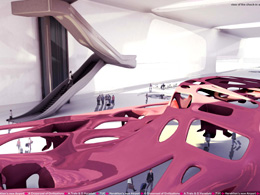STUDENTS PROJECTS
PROJECTS2012

20 March, 2013
Airport: A Crossroad of Civilizations
The example of the new international airport of Heraklion in Kastelli, Crete.
Students: Alma Tralo, Georgia Voradaki
Supervisor: Konstantinos - Alketas Oungrinis
Technical University of Crete - Department of Architecture
Psentestion date : September 2012
While in an airport, every person is just another number code. Passengers coming from all around the world do not interact with each other, although it is undoubted that they have abundant and variable knowledge and experience to exchange. Thus, the following question arises: Is architecture able to favor that communication among individuals in a non-place such as the airport?
Extended description
Contemporary international airports are the definition of the term "non-places". Their structure serves the two and only purposes of transferring and consumerism. There is no room either for the past or the future; only the present exists, abolishing every single trace of reference and history.

Supermodernity is reflected precisely on the design and the function of an airport, where individuality prevails along with the lack of personal identity. Passengers must confirm their identities tactically in specific time and space during their staying at an airport, but between the confirmations they are totally released by them. During these periods of time from one confirmation to the next, the individual acquires a shared identity that is common for all the passengers. Personality is negated and the personal experience and history are passed over until the final exit from the terminal. This relative anonymity provides the individual with a sense of freedom and a condition of solitude and similarity at the same time.
An airport is a place where people from all around the world, with different cultures, traditions, notions, memories and experiences meet. However, they hardly ever interact with each other. Passengers come and go and no kind of communication takes place among them, resulting in losing the chance of getting knowledge from other passengers' experience, with completely different background. In other words, the accumulation of so many people is equivalent to the accumulation of abundant knowledge, which is not utilized in the case of the airport. The exchange of information, even in the simplest way (e.g. chatting), could be considered a valuable contribution to the broadening of an individual's mental horizon. This can be easily achieved in a place such as the airport, where there are so many different people, each one of them carrying his own history. Any personal history includes and carries pure knowledge, which is as unique as the human fingerprint.
But, how can the interaction among passengers be achieved?
After extended research by handing out questionnaires and recording common spatial situations of a typical airport , we set our goal, which was the reconsideration of those characteristics.


The results were embodied in our design plans for the new airport of Heraklion in Kastelli, Crete.

The form of the airport is resulted from 3 curved surfaces that are being folded to create the new building. The 1st curve is coming from the North, the 2nd from the East and the 3rd from the South, signifying the key location of Crete, the crossroad of Europe, Asia and Africa.

Each one of them has a different kind of use. The 1st one includes the entrance and the processing activities (check-in, security, departure lounges). The 2nd includes the non-public spaces: administration offices, maintenance room etc. The 3rd one includes the discretionary activities of the passengers (shops, money exchange).

A very important issue is, also, the furniture-spatial equipment, which is trying to create a more human space, contributing thus to the communication of the individuals.


The atrium that is formed by the two of the three curves plays a major role, as well. It gives a sense of freedom in a space which is totally controlled.


Related articles:
- An overview of the abandoned Nicosia Airport ( 21 July, 2014 )
- International Airport of Thessaloniki ( 04 March, 2014 )










